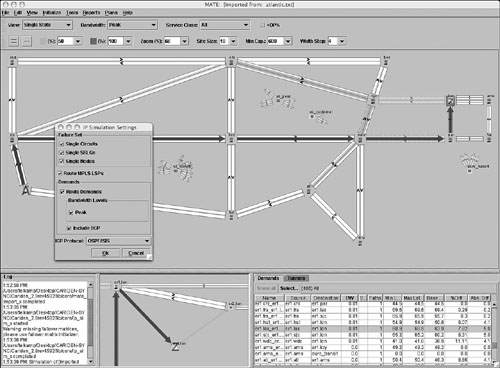Capacity Planning Tools
Several products offer capacity planning capabilities; this section looks at two of them. The goal is not to promote a specific product but to elaborate on the different possibilities of capacity planning applications through a few snapshots.
Note the following:
Typically, you can associate the notion of SLA with capacity planning by inserting the physical distance of every link. That way, the tools have the knowledge of delay by evaluating the propagation time.
You can also associate costs per link upgrade, router upgrade, etc. Consequently, the tool can optimize the monetary investment for maximum reliability.
Today, most products do not collect the core traffic matrix directly from the network. Instead, they import it into the tool, assuming that "someone" generated it, usually in Comma-Separated Value (CSV) format. This creates an additional burden on the operator.
Most applications are considered offline monitoring tools because they do not retrieve information directly from the devices, nor do they automatically reconfigure the network in case of failures.
Typically, the tools provide optimization for IGP metrics, MPLS traffic engineering, etc.
Figure 14-2 shows the Cariden MATE capacity planning tool, where the color scheme codes the different level of bandwidth utilization in each direction. Note that this figure displays a different network than the one shown in Figure 14-1. The possible failure types are as follows:
Link
Router
Shared Risk Link Group (SRLG)
Figure 14-2. Cariden MATE Capacity Planning Tool

SRLG is a group of circuits that may be taken down by a single event. For example, a fiber cut would fail all the circuits traversing the fiber. After the simulation is run, the worst-case scenario of a single failure is displayed, along with its consequences in the network in terms of link utilization and SLAs.
Figure 14-3 shows another network topology represented by the Cisco Network Planning Solution, which is based on OPNET applications and modules. It models the network infrastructure for behavior analysis and presents traffic flow simulations visually to clarify routing dynamics and end-to-end connectivity. The product also shows which traffic flows will be affected by outages and where resulting bottlenecks are likely to occur. Furthermore, it automates capacity planning, resilient link dimensioning, and topology design by validating proposed network changes before deployment.
Figure 14-3. Cisco Network Planning Solution









